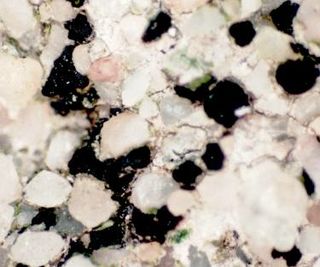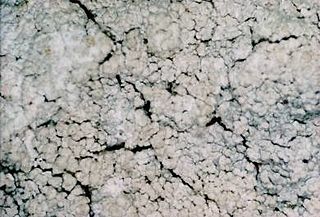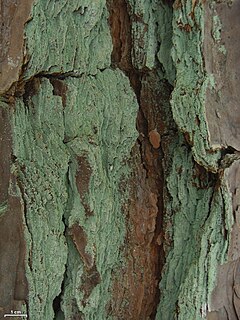
The Stereocaulaceae are a family of lichen-forming fungi in the order Lecanorales. It contains five genera. Species of this family are widely distributed in temperate boreal and austral regions.

Caloplaca is a lichen genus, composed of a number of distinct species. Members of the genus are commonly called firedot lichen, jewel lichen. gold lichens, "orange lichens", but they are not always orange, as in the case of C. albovariegata. The distribution of this lichen genus is worldwide, extending from Antarctica to the high Arctic. It includes a portion of northern North America and the Russian High Arctic. There are about thirty species of Caloplaca in the flora of the British Isles. An example species in this genus is Caloplaca saxicola, a lichen with worldwide distribution including the Antarctic continent, Europe and northern North America including the northern reaches of the Canadian boreal forests.

Sarcogyne is a genus of crustose lichens in the family Acarosporaceae. It was circumscribed by German botanist Julius von Flotow in 1850. A proposal has been put forth in 2021 to assign Sarcogyne clavus as the type species of the genus, "as it represents the original concept of Sarcogyne as having melanized lecideine apothecia without algae in the margin".

Hypocenomyce is a genus of lichen-forming fungi in the family Ophioparmaceae. Species in the genus grow on bark and on wood, especially on burned tree stumps and trunks in coniferous forest. Hypocenomyce lichens are widely distributed in the northern hemisphere.

Lepraria is a genus of leprose crustose lichens that grows on its substrate like patches of granular, caked up, mealy dust grains. Members of the genus are commonly called dust lichens. The main vegetative body (thallus) is made of patches of soredia. There are no known mechanisms for sexual reproduction, yet members of the genus continue to speciate. Some species can form marginal lobes and appear squamulose.
Amandinea maritima is a species of lichen in the family Caliciaceae. Found in Europe, it was described as new to science in 2011.
Echinoplaca schizidiifera is a species of lichen in the family Gomphillaceae. It was described as new to science in 2011. It is found in Venezuela.
Chapsa psoromica is a species of lichen in the family Graphidaceae. Found in Brazil, it was described as new to science in 2011.
Chapsa thallotrema is a species of lichen in the family Graphidaceae. Found in Panama, it was described as new to science in 2011.
Tapellaria albomarginata is a species of lichen in the family Pilocarpaceae. Known from Costa Rica, it was described as new to science in 2011.
Icmadophila eucalypti is a species of lichen in the family Icmadophilaceae. Found in Australia, it was described as new to science in 2011.
Chiodecton pustuliferum is a species of lichen in the family Roccellaceae. Found in Madagascar, it was described as new to science in 2011.

Crustose lichens form a crust that strongly adheres to the substrate, making separation from the substrate impossible without destruction. The basic structure of crustose lichens consists of a cortex layer, an algal layer, and a medulla. The upper cortex layer is differentiated and is usually pigmented. The algal layer lies beneath the cortex. The medulla fastens the lichen to the substrate and is made up of fungal hyphae. The surface of crustose lichens is characterized by branching cracks that periodically close in response to climatic variations such as alternate wetting and drying regimes.
Dust lichens are lichens in either the genus Chrysothrix or genus Lepraria.
Jack Rodney Laundon was a British lichenologist and became President of the British Lichen Society.
Gintaras Kantvilas is an Australian lichenologist, who earned his Ph.D in 1985 from the University of Tasmania with a thesis entitled Studies on Tasmanian rainforest lichens. He has authored over 432 species names, and 167 genera in the field of mycology.

Punctelia borreri is a species of foliose lichen in the family Parmeliaceae. It is a common and widely distributed species, occurring in tropical, subtropical, and temperate regions of Africa, Asia, Europe, North America, Oceania, and South America. The lichen typically grows on bark of deciduous trees, and less commonly on rock. Some European countries have reported increases in the geographic range or regional frequency of the lichen in recent decades, attributed alternatively to a reduction of atmospheric sulphur dioxide levels or an increase in temperatures resulting from climate change.

Lepraria incana is a species of dust lichen in the family Stereocaulaceae. First described scientifically by Johann Jacob Dillenius in 1741, and then formally by Carl Linnaeus in 1753, it is the type species of the genus Lepraria. The thallus of this species is green to greyish-green, and powdery – as if made of tiny granules. These granules are soredia, which are asexual reproductive structures. Like most members of genus Lepraria, the lichen has few distinguishing features, lacking both a medulla and sexual reproductive structures (apothecia). Chemically, the lichen is characterised by the presence of the secondary chemicals known as divaricatic acid and zeorin.

Lepraria harrisiana is a species of leprose lichen in the family Stereocaulaceae. It is widespread in the eastern United States where it occurs in humid habitats, such as conifer swamps and riparian forests.
Lepraria juanfernandezii is a species of dust lichen in the family Stereocaulaceae. It was formally described as a new species by Martin Kukwa in 2019. The type was collected from Robinson Crusoe Island. Here it was found growing on bryophytes that were growing on a rock. It is only known from the type locality. The lichen contains divaricatic acid, a secondary metabolite known to exist in six other Lepraria species.








